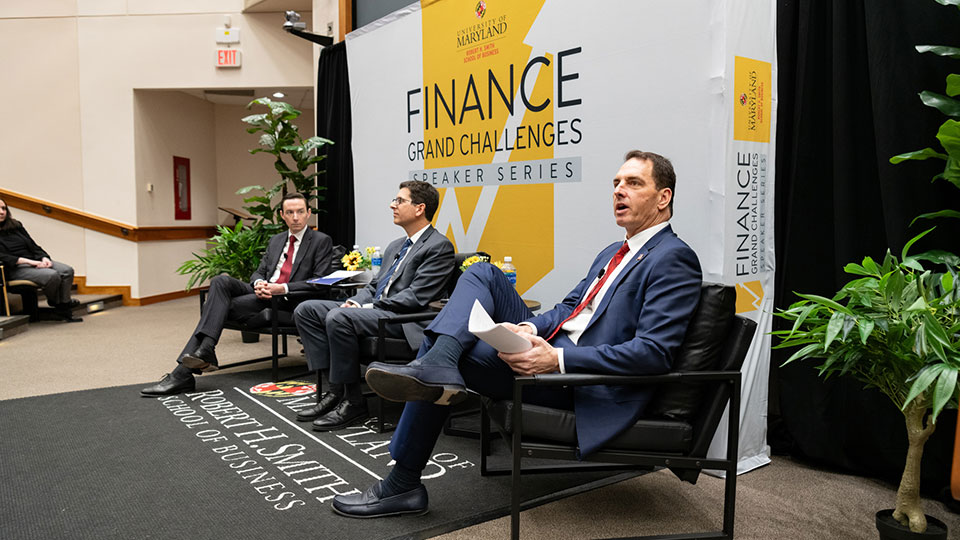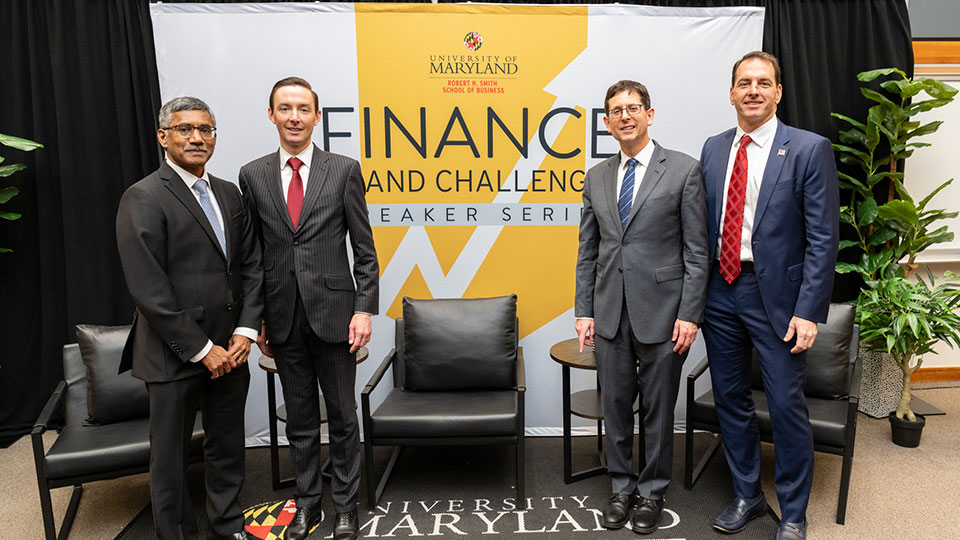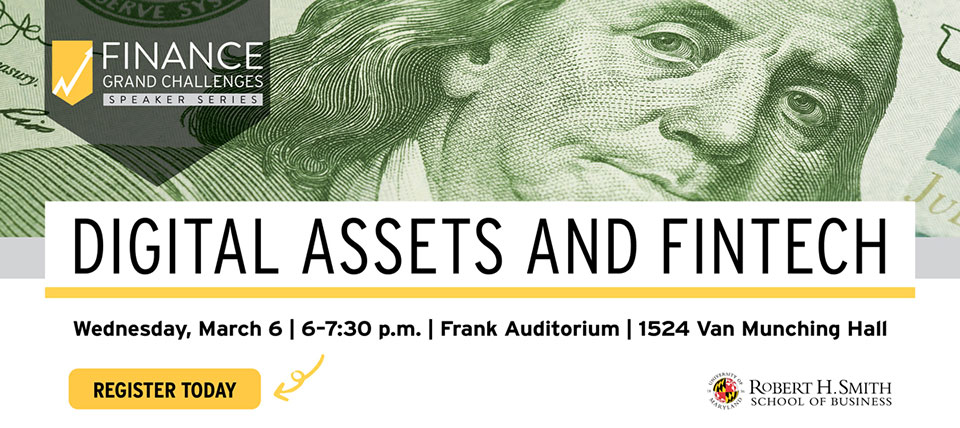
A new speaker series from the University of Maryland’s Robert H. Smith School of Business sees the best minds in the finance world convene to tackle some of the industry’s most pressing issues. On Monday, Feb. 12, 2024, the inaugural event examined its first challenge, the “Unsustainable U.S. Federal Budget.”

The Finance Grand Challenges Speaker Series, presented by the Smith School’s Office of Executive Education, is the school’s latest example of its strategic imperative toward addressing society’s grand challenges. The series, running monthly through May, features a lineup of renowned experts, including White House appointees, Treasury department officials and widely published scholars. Future events will cover topics such as how technology is revolutionizing finance, the student loan burden and the national debt.
Michael Faulkender, Dean’s Professor of Finance and former assistant secretary for economic policy at the U.S. Treasury Department, served as host and moderator of the event. He was joined by Phillip Swagel, Congressional Budget Office director (CBO) and former assistant secretary for economic policy at the Treasury Department, and Tyler Goodspeed, chief economist of ExxonMobil and former acting chairman of the White House Council of Economic Advisers.
Speaking to an at-capacity Frank Auditorium, Dean Prabhudev Konana’s opening remarks stressed the event’s importance of providing students with diverse viewpoints to encourage them to become independent thinkers. “We bring different perspectives, and you make up your mind about what the truth is. That is very important to us in this school,” said Konana.

At the start of the discussion, Faulkender explained the basics of the federal budget. He presented its primary sources of revenue, totaling roughly $5 trillion this fiscal year, as well as the expected $6.5 trillion in outlays, which include discretionary spending, mandatory spending programs and debt service costs. The latter, Faulkender noted, “could be approaching up to a trillion dollars very shortly.”
The figures appeared in the CBO’s latest 10-year forecast. The report projects the U.S. budget situation under current law and policy as a percentage of forecasted gross domestic product (GDP) and compares it to the previous 40 to 50 years.
Because we are at approximately a 100% debt-to-GDP ratio now, “if the economy is growing by about the same amount as the debt is growing, the debt to GDP ratio doesn’t move,” said Faulkender. Additionally, as the Baby Boom generation fully reaches retirement age, outlays grow to approximately 24% of GDP, holding revenues around 18%, and creating a budget deficit ten years from now of about 6.2%. That might explain “why we’re on a path to where the single largest expenditure of the federal government is likely to be debt service cost,” he said.
In a historical view of the data, Swagel highlighted a spike in the deficit during the pandemic from policy response. The effect shared similarities with previous spikes during the financial crisis, but the difference this time is that the deficit remains wide while the labor market has recovered.
“The second challenge is net interest outlays, that is the part of the deficit that we just pay on interest. There’s a sense if you are a policy maker, whatever you want to do, those interest outlays are crowding out all of your other priorities,” said Swagel.
However, Swagel shared optimism for the next 10 years, noting that “the 10-year deficit actually got a little smaller. It got $1.4 trillion smaller,” as a result of recent bipartisan action.

Goodspeed contextualized the CBO’s role in forecasting, not projecting, what it believes to be the most likely outcome for the economy based on legislative policies.
“That can result in some misses,” Goodspeed said, citing subsidies for programs that would add to the debt but be difficult to cut. “That’s not to mention that over the past 75 years or so, in any given year, there is a one-in-six probability that the U.S. economy enters a recession,” which he explained results in a significant spike of government spending and a drop in government revenue. He added that the forecast also assumes no major international armed conflict or additional pandemic, which would also impact federal spending and revenue.
On spending, the panel highlighted the increase in the cost of goods and services, including education and healthcare. Swagel, in alignment with Faulkender, acknowledged the potential ripple effects of an aging population and increasing immigration rates on federal debt.

“By our calculation, the increase in GDP is about $7 trillion from the surge of immigration that we project over the next couple of years, and that in turn leads to about a trillion dollars of additional revenue.” Disproportionately, he said, native population aging is influencing social security and Medicare, with the CBO forecasting that after 2028 “growth in spending on programs for elderly people and rising net interest costs drive up outlays,” and are expected to reach 24.1% of GDP by 2034.
The delicate balance policymakers must strike, according to Goodspeed and Swagel, is creating solutions in which people are not too adversely affected by changes in programs such that proposals are palatable today and also work in the future.
On the revenue side, Faulkender posed the question of how much more receipts to GDP “could we possibly have and yet still realize the economic growth and improvement of living standards that the American people demand?”
Goodspeed used the example of how Western European economies fund their broader social welfare states. “The reality for that model, if you want to fund a lot, you kind of have to go where the base is broadest. And that’s unfortunately in the middle,” he said.
Swagel said, “The gap is between what Americans want and what we’re willing to pay. And I don’t know the answer. Do we want the government we have now that we can’t afford, or do Americans say we don’t want to pay more? Let’s figure out the services we are going to get for what we are willing to pay. Or would we meet somewhere in the middle?”
At the discussion’s conclusion, Swagel reassured the audience with reasons to remain hopeful. “[There are] 5.2 million additional people in the labor force. People want to come here to our country, and the things that people will go through to come here, it's amazing. Capital wants to come here, [as do] businesses and ideas. It just feels like, as a nation, we have a lot of positive things. I’m still optimistic.”

Media Contact
Greg Muraski
Media Relations Manager
301-405-5283
301-892-0973 Mobile
gmuraski@umd.edu
About the University of Maryland's Robert H. Smith School of Business
The Robert H. Smith School of Business is an internationally recognized leader in management education and research. One of 12 colleges and schools at the University of Maryland, College Park, the Smith School offers undergraduate, full-time and flex MBA, executive MBA, online MBA, business master’s, PhD and executive education programs, as well as outreach services to the corporate community. The school offers its degree, custom and certification programs in learning locations in North America and Asia.